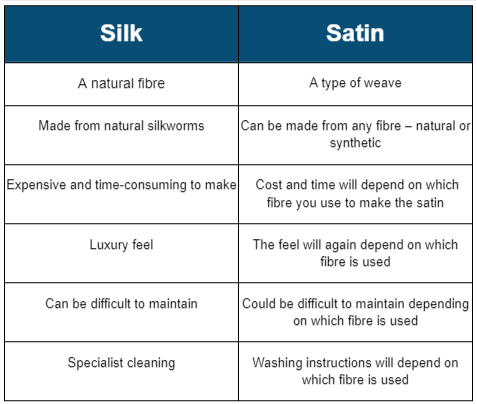Satin vs Sateen
In the vast panorama of textiles available to retailers, designers, and creators, two materials often stand out for their unique […]
Secure Payments
Over 450 fabrics with large stock availability!
Silk and Satin are two completely different things and should not be confused with each other.
Silk is a natural fibre and can be woven into a raw textured cloth, plain weaves, sandwashed finishes, fine chiffons and much more.
Satin is a weave, which produces a shine on the face of the fabric and can be woven using any fibre such as cotton, linen, viscose, silk and more.
Silk fabric is made from the larva of silkworms, especially the bombyx moi species. Silk is luxurious and as expected an expensive cloth. This is because of the quality of fibres used and the time involved in managing the fibre.
The larvae feed on leaves for approximately 40 days and then spin a pod around themselves to pupate. This ‘pod’ is made of high protein fluid which then can then be made into a silk thread. A single cocoon can produce a high level of raw silk threads. The method is completely natural and a delicate process that dates back to as early as 6000 BC.
The first reports of silk originate in China – but is produced all over the world today. Once a very exclusive fabric, now it’s widely used for luxury items such as scarfs, gowns, home décor and nightwear. Even though it is more popular today, producing silk is still a long tedious process. It is possible to get a similar feel from a synthetic fabric, but it does not have the lustre of the real version.
Silk is a versatile fabric, delicate yet durable. Strong but breathable and insulating, it’s also great for those who have sensitive skin because of its organic non-irritating natural nature.
Satin can be made from any of the following fibres, which will reflect the quality and price depending on which one you chose.
Satin can be made from:
• Silk
• Cotton
• Nylon
• Rayon
• Acetate
• Viscose
Satin is recognised for its ‘glossy’ appearance and is popular for use in the manufacture of clothing, interior design and costumes.
The thickness of the fabric will vary depending on the fibre used and the degree of yarn twist. The way in which the fabric is woven gives it that distinctive ‘glossy’ finish. You will often notice that satin has a shiny side and a dull side, which is a result of the weaving process.

Here at Whaleys, we sell many varieties of silk and satin – so you will be spoilt for choice.
Unsure which will be most suitable for your project? Get in touch with one of our sales team today who will be happy to assist.
Check out our range of silk fabrics and satin finishes today.